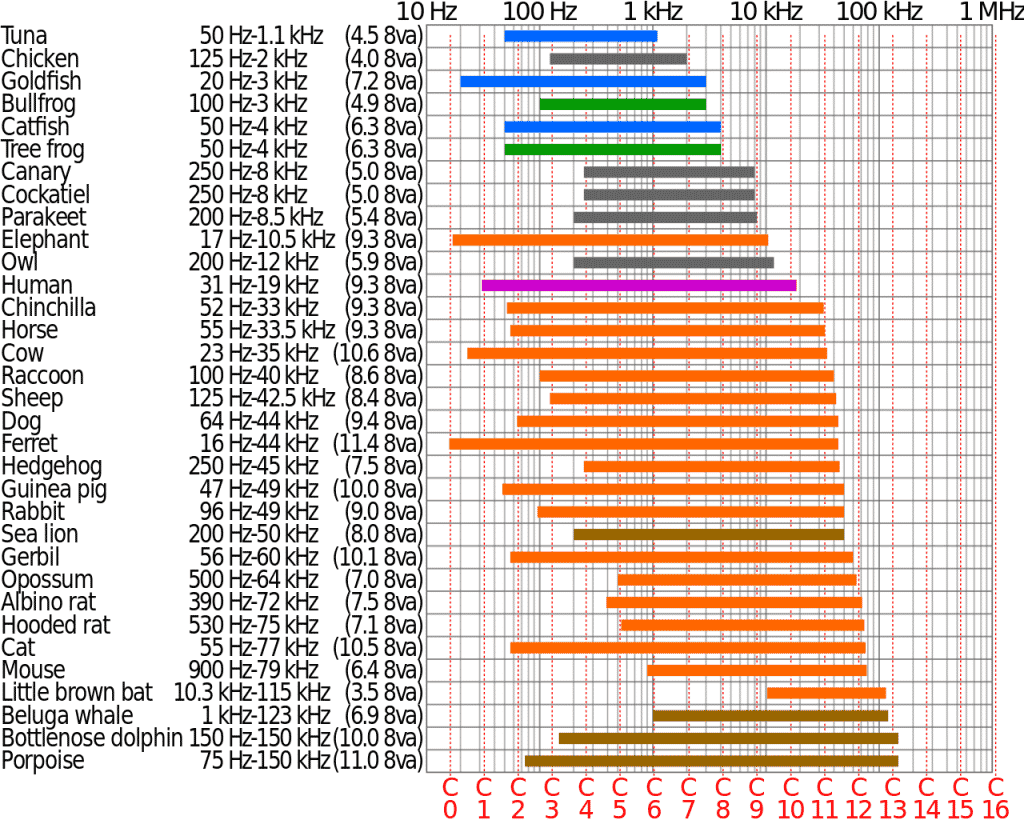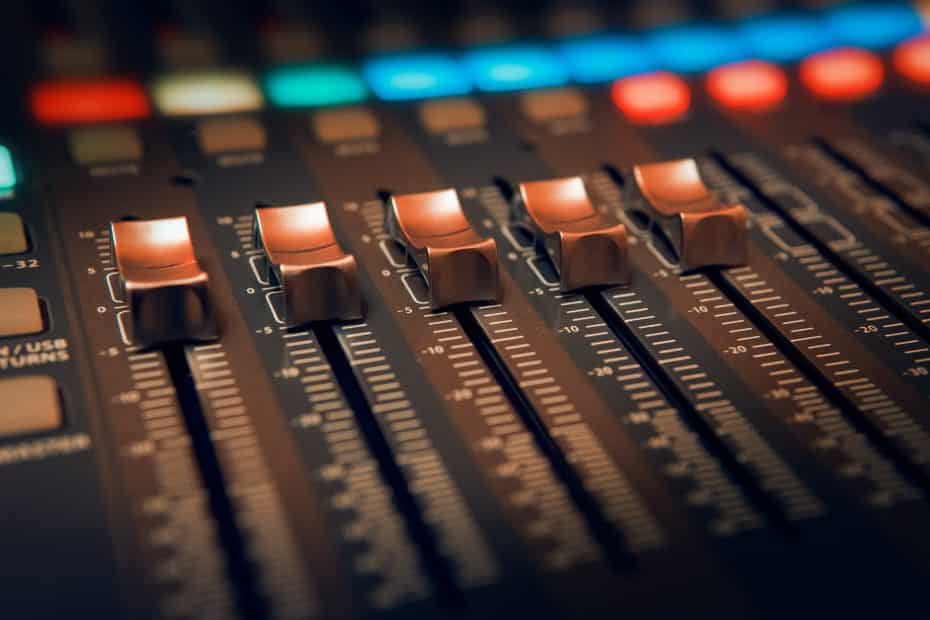Volume is an odd concept. You would think it to be straightforward enough that a volume control makes things louder or quieter, and in the case of guitar amplifiers, one rated at a higher power should be louder. Of course, it’s a fair bit more complicated than that.
Let’s first remind ourselves of a basic definition of sound.
Sound starts with a variation in pressure in a medium transmitted as waves. In our case we are talking mostly about the transmission through air, but it could be through another medium. Aquatic animals, for example, may perceive the changes in the pressure in water. The changes in pressure are detected by something in our biology; mostly ears for us humans, and then interpreted by our brains. It is important to remember that what we call sound requires all these components.
Sound waves vibrate at different frequencies. In the musical sense, we perceive lower frequencies as lower notes and higher frequencies as higher notes. The general range of frequencies that a human with ideal hearing can register is normally quoted as 20Hz to 20KHz. That’s pressure waves in the air oscillating between twenty times per second, and twenty thousand times per second. In special conditions some subjects have been measured hearing slightly wider ranges, however, many people hear a narrower range. Sensitivity to higher frequencies tends to reduce in humans as we get older. For example, at normal levels I don’t hear beyond 15KHz. For many people, it’s less than that. For other animals, the ranges can be quite different.
Here’s an interesting chart of animal hearing ranges:

We normally think of dogs as being able to hear higher frequencies, but generally cats can hear higher. Some marine mammals hear up to 150KHz, which I suppose is no surprise, but Goldfish hear in a lower frequency range, so a lot has to do with the biology of the animal rather than the medium in which they hear. Personally, I was surprised to see that land animals with the widest hearing ranges are cows and ferrets. Who knew?
The point here is that frequency sensitivity is one of several reasons that perception of sound level is different between individuals. Within narrow frequency bands at least, something that seems loud to one person maybe inaudible to another.
Of course, most of the sound we hear is not within narrow bands but is typically a broad spectrum of different frequencies. When we want to measure how loud something could be, we need to have a way to measure these frequencies. In some cases, we need to remove the human element, and in others we may need to account for it in the measurements.
In geometry, the word ‘volume’ has a nice clear explanation and can be measured with defined units. In sound however, volume is a psycho-acoustic term; it depends on perception. We’ll get to this later, but we need to start with something more simply defined. We’ll start with sound pressure (P). Sound pressure is the deviation from the average atmospheric pressure caused by a sound wave. It’s measured as the force on a surface area perpendicular to the direction. P does not take any human hearing characteristics into account; it’s just simply measuring the force. For our purposes we’ll use the SI Unit for P which is Pascals (Pa). The quietest sound most people with unimpaired hearing can hear is commonly noted as 2 x 10-5 Pa or 0.00002 Pa. It’s sometimes described as the sound of a mosquito at 3m.
The problem with using P when relating to human hearing and volume is that there is a huge range of pressure levels that we experience between quietest sound and loudest. Our hearing threshold is 0.00002 Pa, (twenty millionths of one Pa) whereas a very loud sound such as a gunshot or jet engine is maybe 200 Pa. This makes calculations in sound pressure related to human hearing very tedious. The problem is resolved by using a logarithmic scale called sound pressure level (SPL) and it’s measured in decibels (dB). Things should start looking a bit more familiar now.
SPL is measured as a ratio relative to a reference point. The reference point we normally use is our threshold of hearing, which as we already learned is 0.00002 Pa. We’ll call this point 0dB. So, if you have ideal hearing and if you were to sit in a silent room of the type normally only available in lab conditions, and you could just reliably hear a mosquito flying at 3m away, that would be 0dB SPL.
We now can make other measurements relative to 0dB, or the quietest sound we could hear. SPL numbers are much easier to compare and do calculations with than when using SP.
- Hearing threshold – 0dB (0.00002 Pa)
- A normal conversation in a quiet room – around 40dB
- Driving a car on the freeway – around 60dB
- Hearing damage with long term exposure – 85dB
- Jack Hammer at 1m – around 100dB
- Rifle at 1m 140dB (200 Pa)
Notice the 1m measurement in the last two?
Sound pressure decreases in an inverse square as the distance increases from the source. The background noise in a busy restaurant is likely to be similar in different locations because multiple similar noise sources are all around, but if the sound is a single point source, the SPL will change relative to the distance from it. If we move 2m from the jackhammer, the 100dB SPL will drop by about 6dB. (Note that these are ideal examples. The realities are more complex since the environments are rarely ideal. We’ll talk about measuring in real life later). If we move 10m from the jack hammer, the SPL will drop by 20dB. By the time we are 20m from the jack hammer, the SPL has dropped by 26dB to 74dB. At this point, its SPL is likely lower than the noise of surrounding traffic. Although the sound pressure waves from the jack hammer are still present, they are mixed in with all the other sound sources such as cars and people. Our brain is no longer able to pick out the individual jack hammer sound.
To take measurements of SPL we use a SPL meter, a small handheld device that monitors sound pressure with a microphone and displays the results on an LCD. A good meter will take measurements several times per second and be able to display results with different weightings, which we will talk about later. These types of meters are used for instantaneous measurements; they display what the level is right now. When buying an SPL meter look for one that complies with Class 2 standards (IEC 61672-2013 and ANSI/ASA S1.4/Part 1)
Another type of meter is an SPL dosimeter. This takes measurements at intervals and stores the results. It’s generally used to measure someone’s exposure to sound levels over a period of time, such as in occupational regulatory applications.
When measuring SPL, make sure to take account of what you are measuring, from where, and for how long. For example, indicating a band played at 120dB provides limited information as it does not indicate if that is a peak or average value, nor from where the measurement was taken. When measuring specific equipment, it’s best to record as much information about the test as reasonable. For example, we could read that a maximum average SPL for a speaker is 130dB at 1m, on axis, with 1KHz at 1W RMS. Here we would expect that if we put an SPL microphone at 1m from the speaker with the center of the mic in line with the center of the cone and provided a 1KHz tone with a 1W RMS signal level, we would expect an average SPL of 130dB without any damage to the speaker. For extra information, we could provide details on how the averages was determined, as well as environmental conditions such as the type of room, ambient temp etc.
Here is a quick recap of what we have learned.
We’ve covered that sound is created from pressure waves of different frequencies and that individual people (and other animals) hear over different frequency ranges. In audio engineering, to measure the strength of these pressure waves we use a logarithmic scale of ratios called sound pressure level (SPL) that uses units of decibels (dB). We do this because the measurement of sound pressure, which uses the units of Pascals (Pa) has too fine of a scale, making calculations too complicated.
Sound pressure level measurements are relative to a reference which we label 0dB. We normally take 0dB to be the quietest sound that a human with perfect hearing can hear in ideal conditions, which is often described as the sound of a flying mosquito at 3m. Sound pressure level is relative to distance and decreases as an inverse square as the distance from the source increases. To measure SPL, we use an electronic device called an SPL meter. Depending on the application we can measure the current SPL, or we can record exposure to SPL over time. If we are measuring a point source, we should at least take account of the distance from the source the measurement was taken and we may need to compare peak and average values.
Sound is an interesting subject that, as you can see, is far more complex than it initially appears. Hopefully, this lesson gave you an entirely new appreciation for sound and volume.
